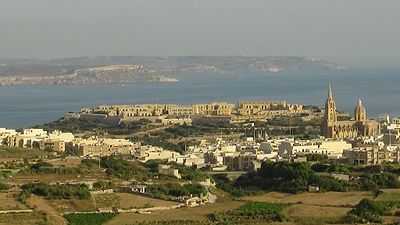Fort Chambray
| Fort Chambray | |
|---|---|
| Mġarr, Gozo, Malta | |
|
View of Fort Chambray from the landward side | |
| Coordinates | 36°01′21″N 14°17′40″E / 36.02250°N 14.29444°E |
| Type | Coastal fortification |
| Site information | |
| Condition | Partially destroyed |
| Site history | |
| Built | 1749-1760s |
| Built by | Order of Saint John |
| Materials | Limestone |
| Battles/wars | Capture of Malta (1798) |
Fort Chambray is a former fort situated in the precincts of Għajnsielem, on the island of Gozo, Malta. This fortress was built in the area of Ras it-Tafal which is situated between the port of Mġarr and that of Xatt l-Aħmar. Large parts of the fort were demolished but the outer bastions and some barracks still survive.
History
The possibility of building a fort west of Mġarr had been investigated back in 1599 by Giovanni Rinaldi, however he rejected the proposal since the site was dominated by higher terrain in the north and the limestone in the area was too soft to build a good fortress. The construction of a fort there was reconsidered again in 1714 and the French engineer Jacob de Tigné made a design, however construction was postponed indefinitely due to a lack of funding.
Eventually, Jacques François de Chambray was appointed Governor of Gozo in 1749, a post which he retained to his death in 1756. He agreed to finance the building of the fort, and it was named after him. Construction commenced that same year in 1749, and by 1757 the land front of the fort was largely complete.
The fort was originally intended to be a new fortified city like Valletta, and eventually the new capital of Gozo instead of the Cittadella. The project was unsuccessful because by the time construction started, Berber and Turkish marauders were no longer a major threat and people began feeling safer living in the rural areas. While the fort was built, it never developed into a city as planned.[1]
During the last few years of the Knights' rule in Malta, the fortress never experienced any attack mainly due to the decline of the Order's enemy the Ottoman Empire. In 1798, it was Gozo's defence against the revolutionary forces of Napoleon, and this was the fort's only brief military adventure.
During the first four decades of British rule, the fort's importance diminished. By 1830 a small military hospital was located in the fort. It was then abandoned for several years but found a new lease of life when several British regiments were stationed there during the Crimean War and the hospital was expanded. When the war ended, the fort resumed normal duties once again. The fort and its hospital again saw a lot of activity during the Anglo-Egyptian War in 1882 and World War I from 1914 to 1916. Over the years, three cemeteries were built, one within the fort and two in the ditches.
After World War I, the fort closed down and was used as a civilian mental hospital from 1934 to 1983. In the early 1990s plans were made to convert the fort into a tourist destination. By 1991 the human remains in the cemeteries were removed and were reburied in Xewkija, and the tombstones were set aside in a secluded part of the fort.[2]
Present day
In the 1990s large parts of the fortification were demolished, although the outer bastions and the barracks were retained. The project was later abandoned and restarted under Dr. Michael Caruana who has created a unique development of which phase one and two is completed. Phase three has recently received outline planning permission.
References
| Wikimedia Commons has media related to Fort Chambray. |
- ↑ "Fort Chambrai". Visit Gozo. Retrieved 10 October 2014.
- ↑ "Fort Chambray - Gozo". Malta Family History. Retrieved 10 October 2014.
